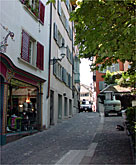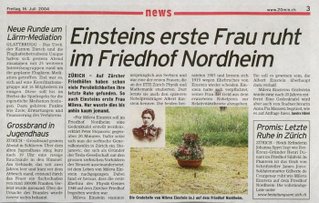 The Slavs haven’t made much of a mark on Zurich so far, but there are a couple significant points of interest.
The Slavs haven’t made much of a mark on Zurich so far, but there are a couple significant points of interest.One of the more random Slavic landmarks is Cafe Odeon (Limmatquai 2), where Vladimir Lenin whiled away the hours planning the Russian Revolution. Lenin lived in exile in Geneva from 1903-1905 and in 1908, and then from 1914-1915 in Bern, where he quickly became disillusioned by the locals’ lack of interest in his theories of Communism.
 In 1916, he moved to Zurich and found an apartment at Spiegelgasse 14. There, he continued his revolutionary activities. Among the highlights of his carrier in Zurich was the completion of “Imperialism: the Highest Stage of Capitalism.” On 9 April 1917, Lenin was able to return to St. Petersburg to lead the Revolution.
In 1916, he moved to Zurich and found an apartment at Spiegelgasse 14. There, he continued his revolutionary activities. Among the highlights of his carrier in Zurich was the completion of “Imperialism: the Highest Stage of Capitalism.” On 9 April 1917, Lenin was able to return to St. Petersburg to lead the Revolution.Alexander Solzhenitsyn’s Lenin in Zurich details this period in Lenin’s life. Zurich was also home to Leon Trotsky for a time.
Relations between Switzerland and Russia were strained after a tragic 2002 plane crash, but this has not stopped Russian tourists from visiting Zurich. However, Russians are more likely to come to Zurich to spend money these days rather than to plan revolutions.
 Another Slavic point of interest is the grave of Albert Einstein’s first wife, Mileva Maric (1875-1948) of Titel, near Novi Sad, in Serbia. She died in Zurich on 4 August 1948 and is buried in the city’s Northeim Friedhof Cemetery. The grave is currently unmarked, however, and New York’s Tesla Memorial Society is trying to raise funds to restore the site.
Another Slavic point of interest is the grave of Albert Einstein’s first wife, Mileva Maric (1875-1948) of Titel, near Novi Sad, in Serbia. She died in Zurich on 4 August 1948 and is buried in the city’s Northeim Friedhof Cemetery. The grave is currently unmarked, however, and New York’s Tesla Memorial Society is trying to raise funds to restore the site. About 213,900 strong, Serbian and Montenegrin nationals make up the second-largest group of foreigners in Switzerland after the Italians. Taken together, there are about 370,000 former Yugoslav nationals in the country. They haven’t made much of a mark on Zurich yet, though. There are also a number of Rusyns from the former Yugoslavia living in Switzerland.
About 213,900 strong, Serbian and Montenegrin nationals make up the second-largest group of foreigners in Switzerland after the Italians. Taken together, there are about 370,000 former Yugoslav nationals in the country. They haven’t made much of a mark on Zurich yet, though. There are also a number of Rusyns from the former Yugoslavia living in Switzerland.







No comments:
Post a Comment